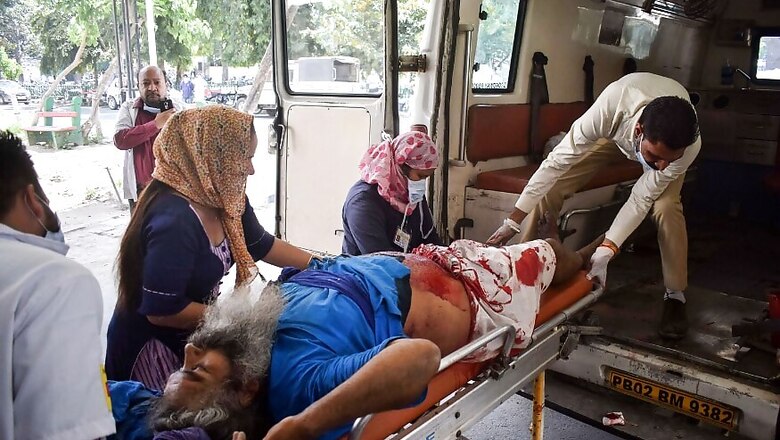
views
Chandigarh: The brutal attack on an assistant sub-inspector and some others at a sabzi mandi in Patiala district by a group of men in Nihang attire shook Punjab early on Sunday.
The ASI’s hand was chopped off with a sword and two other policemen were injured when the Nihangs attacked them after being asked to show curfew passes at the vegetable market. Later in the day, doctors at Chandigarh’s PGIMER successfully reattached an ASI’s hand.
Seven people, including five attackers, were arrested hours later after an exchange of fire at a gurdwara where the group fled after the 6.15 am incident in Sanaur town.
Political leaders cutting across party lines condemned the incident and sought strict action against perpetrators of the crime.
As widespread criticism poured in, many wanted to know more about the community. Balkar Singh, a Sikh scholar, said the Nihangs came into being as ‘Laadli Fauj’ of the Guru. Guru Gobind Singh, the 10th Sikh Guru gave them the special blue attire while the sixth Guru Hargobind constituted a special army comprising the Nihangs.
Sunday’s incident of lawlessness can be attributed to the fact that the Nihangs do not wish to follow any order from the administration as they perhaps consider it an attack on their sovereignty, Singh said, adding, the community believes it follow orders of only the Guru and no one else.
Originally led by Baba Phoola Singh with their centre in Amritsar, the Nihangs were made part of Maharaja Ranjit Singh’s battalion for their fighting prowess.
Described as “the one who is Nirbhau (fearless)” by Guru Arjan Dev, the Nihangs still live life the traditional way. They are known for reciting the holy Jaapji Sahib Paath while performing the Gatka dance, a martial art form of the Sikhs. In Punjab, no one refuses them anything out of reverence, Balkar Singh said.
Nihangs were the original Akalis or followers of “Akal”, the Sikh temporal seat. They used to run the Akal Takht before the Akali Dal took over after a resolution was passed in 1925. Hence, the Nihangs are considered original Sikh Jathedars.
Nihangs have many thriving gurdwaras across Punjab and mostly live on vast jagirs of these gurdwaras, also known as ‘Bagchi’.
They are also known for consuming cannabis (they call it ‘sukha prasad’ or ‘sukh nidhan’, one that gives pleasure) during meditation. Though marriage is not prohibited among the Nihangs, most of them remain single and dedicate their lives to the faith, said Balkar Singh.
“In spirit, they are considered the purest of the pure, because they are associated with the Sikh Guru, so they follow the Guru’s orders only. The true ‘panthic’ or followers of the Sikh Panth, the Nihangs practise the ‘rehat maryada’ after ‘amrit chhakna’ (Sikh baptism). The martial arts of the Sikhs like Gatka, horse riding are practised by them even today and are on display during Hola Mohala festival,” Balkar Singh said.
“In practice, they live like ‘Chalde Vaheer’ (always travellin). In earlier times, this used to be on horses. Now, they have switched to swanky cars.
“Also, the chain of public schools of the Budha Dal, a section among Nihangs started by Baba Santa Singh, is considered the most modern ones in Punjab. They have set up these schools in Patiala, Mohali and Samana,” Singh said.
Read all the Latest News, Breaking News and Coronavirus News here. Follow us on Facebook, Twitter and Telegram.




















Comments
0 comment